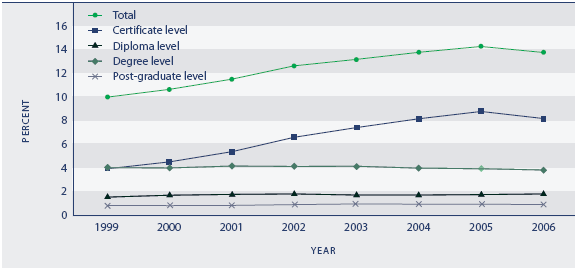Participation in tertiary education
Definition
The proportion of the population aged 15 years and over enrolled at any time during the year in formal tertiary education leading to a recognised New Zealand qualification.
Tertiary education providers include public institutions (universities, polytechnics, colleges of education, wānanga), and private tertiary education providers receiving government funding or approval, or registered with the New Zealand Qualifications Authority. Qualifications range from certificates and diplomas to bachelor and post-graduate degrees. Domestic students only are included.
Relevance
The acquisition of a tertiary qualification provides individuals with additional skills and knowledge to participate in society and in the economy.
Current level and trends
During 2006, 13.7 percent of people aged 15 years and over (448,000 people) were enrolled in formal tertiary education, a slight decline from 14.2 percent (457,000 people) in 2005. This slight decline could be attributable in part to the strong labour market encouraging people into employment rather than further education.
Most of the decline in tertiary education participation between 2005 and 2006 was due to a fall in the number of people taking Levels 1–3 certificate courses. The rate of participation in certificate level courses as a whole (ie Levels 1–4) grew strongly between 1999 and 2005 (from 4.0 percent to 8.8 percent), then fell to 8.1 percent in 2006. In total, 10 percent of people aged 15 years and over were enrolled in sub-degree tertiary education courses in 2006, up from 6 percent in 1999. In comparison, the proportion enrolled in degree and post-graduate courses remained fairly steady at around 5 percent over the period 1999–2006.
Figure K3.1 Tertiary education participation rate, by qualification level, 1999–2006

Source: Ministry of Education
Age and sex differences
Tertiary education participation is highest among 18–24 year olds (36.5 percent in 2006), followed by 25–39 year olds (16.6 percent). The participation rate for 18–24 year olds changed little between 1999 and 2006. In contrast, the rate for people aged 40 years and over and people aged 25–39 years increased substantially over that period.
Since the mid-1990s, women have been more likely than men to participate in tertiary study at ages 18 years and over. However, as females accounted for all of the decline in enrolments between 2005 and 2006, the sex gap has narrowed slightly. In 2006, there was no sex difference in the proportion enrolled in sub-degree courses (10 percent of males and females), but females were more likely than males to be enrolled in degree and post-graduate courses (6 percent and 4 percent, respectively).
Table K3.1 Tertiary participation rates (%), by age and sex, selected years, 1999–2006
| |
15–17 |
18–24 |
25–39 |
40+ |
Total |
| Males |
| 1999 |
9.2 |
32.3 |
10.0 |
2.7 |
9.1 |
| 2001 |
11.0 |
34.0 |
12.0 |
3.5 |
10.2 |
| 2005 |
14.6 |
33.2 |
15.1 |
6.7 |
12.9 |
| 2006 |
10.8 |
33.5 |
14.8 |
7.1 |
12.8 |
| Females |
| 1999 |
8.3 |
35.7 |
12.8 |
4.4 |
10.8 |
| 2001 |
11.2 |
38.9 |
15.8 |
5.5 |
12.7 |
| 2005 |
12.3 |
39.6 |
19.6 |
8.5 |
15.4 |
| 2006 |
9.4 |
39.6 |
18.3 |
8.1 |
14.6 |
Source: Ministry of Education
Ethnic differences
In 2006, the age-standardised tertiary education participation rate was highest for Māori at 18 percent, followed by the Asian ethnic group (15 percent), Europeans (13 percent) and Pacific peoples (12 percent). The increase in the age-standardised rate between 1999 and 2006 was higher than average for the Asian and Māori ethnic groups. The slight fall in the age-standardised rate between 2005 and 2006 occurred across all ethnic groups but was larger than average for Māori, Pacific peoples and Asian ethnic groups.
At the core tertiary education age group 18–24 years, the European ethnic group had the highest participation rate in 2006 (37 percent), while the rate for the Asian ethnic group (32 percent) was slightly above that of Māori and Pacific peoples (each 31 percent). Between 2002 and 2006, the participation rate of 18–24 year olds remained steady for the European ethnic group, declined for Māori, and increased for the Pacific peoples and Asian ethnic groups.
At older ages, Māori had the highest tertiary participation rates in 2006, followed by the Asian, Pacific peoples and European ethnic groups.
Table K3.2 Tertiary participation rates (%), by age and ethnic group, 2006
| Age group |
European |
Māori |
Pacific peoples |
Asian |
| 15–17 |
9.2 |
12.7 |
8.1 |
5.3 |
| 18–24 |
37.2 |
30.9 |
31.1 |
32.4 |
| 25–39 |
14.4 |
22.6 |
15.2 |
17.0 |
| 40+ |
6.1 |
15.6 |
7.5 |
12.2 |
| Total |
11.6 |
20.3 |
14.6 |
17.6 |
Source: Ministry of Education
Māori and Pacific students are less likely to be enrolled in degree-level courses than students from the European or Asian ethnic groups. Almost 90 percent of the decline in Māori enrolments between 2005 and 2006 was due to fewer Māori taking Levels 1–3 certificate courses.
International comparison
There are no robust measures of tertiary participation across OECD countries.Some indication of New Zealand's relative standing can be gained from the proportion of people enrolled in education at various ages. In 2004, 30 percent of 20–29 year olds (the age group more likely to be enrolled in tertiary than secondary education) were enrolled in education, placing New Zealand seventh out of 28 countries. This was above the OECD median of 25 percent. The New Zealand rate was higher than those of the United Kingdom (28 percent) and the United States (23 percent) but below the rate for Australia (33 percent).44
|

